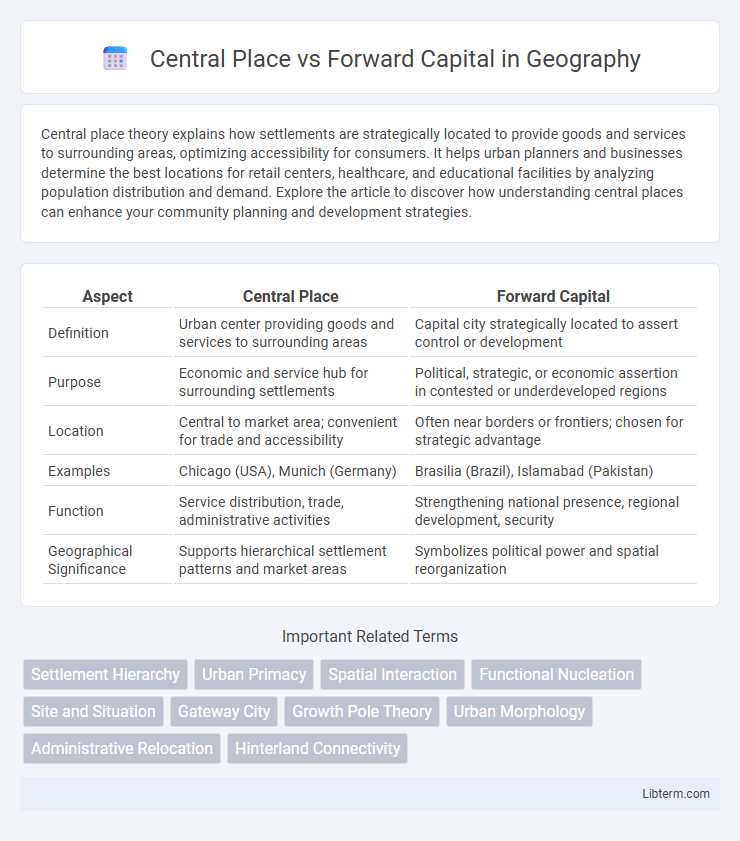Central place theory explains how settlements are strategically located to provide goods and services to surrounding areas, optimizing accessibility for consumers. It helps urban planners and businesses determine the best locations for retail centers, healthcare, and educational facilities by analyzing population distribution and demand. Explore the article to discover how understanding central places can enhance your community planning and development strategies.
Table of Comparison
| Aspect | Central Place | Forward Capital |
|---|---|---|
| Definition | Urban center providing goods and services to surrounding areas | Capital city strategically located to assert control or development |
| Purpose | Economic and service hub for surrounding settlements | Political, strategic, or economic assertion in contested or underdeveloped regions |
| Location | Central to market area; convenient for trade and accessibility | Often near borders or frontiers; chosen for strategic advantage |
| Examples | Chicago (USA), Munich (Germany) | Brasilia (Brazil), Islamabad (Pakistan) |
| Function | Service distribution, trade, administrative activities | Strengthening national presence, regional development, security |
| Geographical Significance | Supports hierarchical settlement patterns and market areas | Symbolizes political power and spatial reorganization |
Introduction to Central Place and Forward Capital
Central Place theory explains how settlements with varying sizes and services are spatially distributed to optimize accessibility and economic efficiency. Forward Capital refers to a strategically relocated capital city positioned to promote national integration, economic development, or geopolitical advantage. Both concepts are crucial in urban planning and regional development for understanding spatial organization and political strategy.
Defining Central Place: Concepts and Characteristics
Central Place theory defines a spatial structure where settlements serve as 'central places' providing services to surrounding areas, characterized by hierarchical urban functions and market areas. These central places are strategically located to optimize accessibility and minimize transportation costs, ensuring efficient distribution of goods and services. Key characteristics include a spatial hierarchy, threshold populations for service viability, and a range of goods reflecting different levels of demand.
Forward Capital: Meaning and Strategic Purpose
A forward capital is a strategically relocated seat of government established away from the traditional or historical capital to enhance political control, economic development, or security in a region. Unlike central places that primarily serve as commercial or service hubs within a spatial distribution, forward capitals symbolize national integration, territorial consolidation, and geopolitical leverage. Examples like Brasilia in Brazil and Islamabad in Pakistan illustrate how forward capitals drive urbanization and regional growth while asserting governmental presence in underdeveloped or contested areas.
Historical Examples of Central Places
Historical examples of central places include cities like Rome and Constantinople, which functioned as primary hubs for trade, governance, and culture in the Roman and Byzantine Empires. These central places facilitated economic activity and administrative control over vast territories, serving as focal points for surrounding regions. Unlike forward capitals such as Brasilia, which are strategically relocated to promote development, central places naturally emerged due to geographical advantages and economic significance.
Case Studies of Forward Capitals
Brasilia in Brazil exemplifies a successful forward capital, strategically relocated from Rio de Janeiro to promote internal development and reduce coastal congestion. Similarly, Abuja in Nigeria was established to replace Lagos, aiming to create a neutral administrative center and foster national unity. These case studies highlight how forward capitals serve as instruments for political decentralization and economic stimulation in developing regions.
Economic Functions of Central Places vs Forward Capitals
Central places primarily serve as economic hubs that facilitate trade, distribution of goods, and provision of services within a defined market area, optimizing accessibility for surrounding populations. Forward capitals, strategically relocated cities, are often established to stimulate economic development, enhance political control, and promote regional integration, acting as catalysts for infrastructure growth and investment in underdeveloped areas. While central places focus on sustaining economic functions through local commerce and service delivery, forward capitals drive transformative economic impacts by attracting urbanization and diversifying regional economies.
Political Implications of Forward Capitals
Forward capitals often serve strategic political purposes by asserting control over contested regions and signaling commitment to national integration. Relocating the administrative center can redistribute political power and economic development toward marginalized or border areas, reducing regional disparities. This strategic placement also enhances security and governance by situating government institutions closer to potential conflict zones or key geopolitical frontiers.
Urban Planning and Spatial Dynamics
Central place theory explains the spatial organization of urban settlements by analyzing the distribution and size of cities based on their roles in providing goods and services, influencing urban planning through hierarchical structuring of market areas. Forward capitals, strategically positioned new administrative capitals established away from traditional urban centers, drive spatial dynamics by promoting regional development and redistributing population density, often reshaping transportation networks and economic activity. Urban planners leverage these concepts to optimize land use, infrastructure deployment, and balanced regional growth within metropolitan regions.
Advantages and Disadvantages: Central Place vs Forward Capital
Central Place offers efficient access to resources and services by situating administrative functions centrally, enhancing regional integration and reducing transportation costs. Forward Capitals stimulate development in strategic locations, promoting political stability and national unity but often incur high relocation expenses and face infrastructural challenges. While Central Places optimize existing economic hubs, Forward Capitals can redistribute population growth yet risk isolation from established economic centers.
Future Trends and Evolving Roles
Central places increasingly integrate smart technologies and decentralized infrastructures, enhancing real-time connectivity and localized decision-making to foster sustainable urban growth. Forward capitals are evolving as political and economic hubs with advanced digital governance systems, promoting resilience in crisis management and facilitating global collaboration. Emerging trends emphasize hybrid models that combine the accessibility of central places with the strategic functions of forward capitals, driven by data analytics and AI for optimized regional development.
Central Place Infographic

 libterm.com
libterm.com